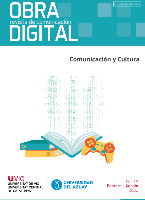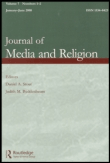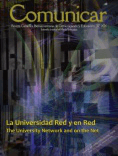
Obra Digital-Revista de Comunicacion
Scope & Guideline
Bridging theory and practice in contemporary communication.
Introduction
Aims and Scopes
- Transmedia Narratives and Digital Culture:
The journal explores the role of transmedia storytelling in contemporary media, emphasizing how narratives expand across different platforms and engage audiences in unique ways. - Gender Studies in Media:
A significant focus is placed on gender representation and discrimination within media contexts, analyzing the roles and visibility of women in journalism, sports, and various forms of digital content. - Impact of Social Media:
The journal addresses the influence of social media on communication practices, identity formation, and community engagement, particularly in the context of activism and cultural representation. - Educational Communication:
Research on the use of digital tools and media literacy in education is prominent, examining how these elements enhance learning experiences and address contemporary educational challenges. - Cultural Representation and Identity:
The journal investigates the representation of diverse identities in media, including the portrayal of marginalized groups and the role of digital narratives in shaping societal perceptions. - Media and Technology Intersections:
A core area of interest is the relationship between media technologies and societal changes, particularly how innovations impact communication strategies across various sectors.
Trending and Emerging
- Fandom and Interactive Narratives:
There is a growing focus on fandom, particularly in relation to interactive and alternate reality games, which explore the role of fan engagement in shaping narratives and content within popular culture. - Digital Activism and Social Movements:
The journal has increasingly published research on digital activism, analyzing how social media platforms facilitate collective identities and movements, particularly in the context of gender and social justice. - VTubers and New Media Forms:
Research on VTubers and their transmedia capacities is emerging as a significant theme, examining the intersection of digital content creation, fan culture, and identity construction in contemporary media. - Gender Discrimination in Media:
The analysis of gender discrimination, particularly within media convergence and sports communication, has gained traction, reflecting a heightened awareness of these issues in current discourse. - The Role of Technology in Education:
There is an upward trend in exploring how technology influences educational practices, with a focus on enhancing digital competencies and media literacy in various educational contexts.
Declining or Waning
- Traditional Journalism Practices:
There seems to be a waning interest in traditional journalism practices, with fewer studies focused on conventional reporting methodologies, as the journal shifts towards more innovative and digital approaches. - General Media Literacy:
While media literacy remains important, the emphasis on general media literacy topics appears to have decreased, with more specific themes like digital competencies and targeted media engagement taking precedence. - Historical Analysis of Communication:
Research that focuses on historical perspectives of communication and media seems to be less frequent, suggesting a move towards contemporary studies that address current digital and social issues. - Print Media Analysis:
Analysis specifically centered on print media has diminished, possibly reflecting the broader trend of declining print media relevance in favor of digital platforms and their associated narratives.
Similar Journals

IC-Revista Cientifica de Informacion y Comunicacion
Unveiling New Perspectives in Library and Information SciencesIC-Revista Cientifica de Informacion y Comunicacion, published by UNIV SEVILLA, EDITORIAL, stands at the forefront of academic discourse in the fields of Communication, Cultural Studies, Library and Information Sciences, and Linguistics and Language. With its ISSN 1696-2508 and E-ISSN 2173-1071, this esteemed journal showcases high-quality research, contributing significantly to the advancement of knowledge since its inception in 2016. The journal is recognized for its rigorous standards, holding a Q2 category in Communication, a Q1 category in Cultural Studies, as well as Q2 rankings in both Library and Information Sciences and Linguistics and Language as of 2023. With a growing reputation, it is ranked in the mid percentiles across various Scopus categories, marking it as a key player in its spheres of influence. Although not an open-access journal, it remains accessible through institutional subscriptions, making it a vital resource for scholars and practitioners alike. The editorial team is dedicated to fostering innovation and engagement within the academic community, aligning with the evolving dynamics of information and communication.

Austral Comunicacion
Connecting scholars to the world of communication.Austral Comunicacion, published by the esteemed Universidad Austral within its Faculty of Communication, is an open-access journal dedicated to advancing the field of communication studies. Since its inception in 2012, this journal has emerged as a vital platform for scholarly discourse, fostering new ideas and methodologies within the discipline. With the increasing importance of communication in our globalized world, the journal serves as a crucial resource for researchers, professionals, and students looking to explore the dynamics of media, culture, and communication practices. The journal's accessibility ensures that cutting-edge research reaches a global audience, promoting collaboration and innovation in the field. Operating under the ISSN 2313-9129 and E-ISSN 2313-9137, Austral Comunicacion is poised to continue its significant impact on communication studies as it transitions into its latest converged years of 2023 to 2024.

Revista Comunicacao Midiatica
Illuminating the Intersections of Media and SocietyRevista Comunicação Midiática is a prominent academic journal focusing on the fields of communication, media studies, and cultural dynamics, published by Universidade Estadual Paulista Júlio Mesquita Filho, Facility of Architecture, Arts & Communication. With its ISSN 2236-8000, this journal aims to disseminate innovative research, theoretical advancements, and practical insights that contribute to a deeper understanding of communication processes in contemporary society. Although it currently does not provide Open Access options, the journal serves as a valuable resource for researchers, professionals, and students who are keen to explore the intricate relationships between media and culture. Located in Bauru, Brazil, the journal is committed to fostering multidisciplinary dialogue and enhancing scholarly discourse, making it an invaluable addition to the academic landscape in the realm of media studies.

Global Media Journal-Canadian Edition
Fostering Scholarly Insights in an Evolving Media Landscape.Global Media Journal-Canadian Edition is a prestigious academic outlet that delves into the intersections of communication, media studies, and cultural discourse. Published by the University of Ottawa's Department of Communication, this journal serves as a platform for innovative research and critical analysis, highlighting the dynamics of media in a global context with a specific focus on Canadian perspectives. Since its transition to Open Access in 2008, the journal has greatly expanded its readership and accessibility, enabling a wider dissemination of knowledge. Despite facing a Q4 category quartile ranking in 2023 for the field of Communication, it continues to promote scholarly dialogue and is a valuable resource for researchers, professionals, and students alike, eager to explore contemporary media issues. The journal has documented converge years from 2013 to 2017 and 2021, fostering timeless discourse that resonates with the ever-evolving landscape of media and communication.

Revista Comunicacion
Cultivating Critical Conversations in the Heart of CommunicationRevista Comunicacion is a prestigious academic journal published by Escuela Ciencias Lenguaje, dedicated to advancing the field of communication studies. With its ISSN 0379-3974 and E-ISSN 1659-3820, this journal serves as a vital platform for researchers, professionals, and students alike to disseminate cutting-edge research, innovative methodologies, and critical discussions pertaining to communication theory and practice. Though currently not an open-access publication, the journal emphasizes the importance of accessibility and the sharing of knowledge within the academic community. With its focus on the interdisciplinary nature of communication, Revista Comunicacion aims to foster intellectual exchange and collaboration among scholars, thereby contributing to the understanding of communication's pivotal role in contemporary society. Its location in Cartago, Costa Rica, serves as a hub for regional research while also maintaining a global perspective. This journal stands as an essential resource, paving the way for future contributions in the rapidly evolving landscape of communication studies.

Journal of Media and Religion
Advancing Knowledge at the Nexus of Media and ReligionThe Journal of Media and Religion is a leading interdisciplinary journal dedicated to exploring the complex interactions between media and religion. Published by Routledge Journals, Taylor & Francis Ltd, this journal serves as a critical platform for researchers and practitioners within the fields of communication and religious studies. With an impressive impact factor and a distinguished ranking—placing it in the top quartile for Religious Studies and the second quartile for Communication—Journal of Media and Religion showcases high-quality research that enhances our understanding of how media influences religious practices and vice versa. The journal has been converging insightful contributions from 2010 to 2024, fostering scholarly dialogue and innovative methodologies. As an essential resource for academics, professionals, and students alike, it promotes open access to groundbreaking studies, facilitating the exchange of ideas that shape both fields.

Doxa Comunicacion
Elevating voices in the study of modern communication.Doxa Comunicación is a prominent open-access journal dedicated to advancing the field of communication studies, published by Universidad San Pablo CEU, under the Faculty of Humanities and Communication Sciences. Established in 2003, this journal has gained recognition for its commitment to disseminating high-quality research and thought-provoking articles, fostering a vibrant academic community. With an ISSN of 1696-019X and an E-ISSN of 2386-3978, Doxa Comunicación occupies a vital niche in the academic landscape of Spain, contributing to both national and international discourses. In the 2023 rankings, it is categorized in the Q3 quartile within the fields of Communication and Social Sciences (miscellaneous), reflecting its competitive standing among peer publications. The journal's diverse scope, including contemporary communication theories and practices, ensures relevance for researchers, professionals, and students alike. With a Scopus rank of #333 in Social Sciences (miscellaneous) and #291 in Communication, Doxa Comunicación serves as an essential platform for innovative research that addresses the complex challenges of modern communication in a rapidly evolving society.

Plaridel
Fostering Innovative Research in the Heart of Communication.Plaridel is an esteemed academic journal dedicated to the field of communication, published by the University of the Philippines Diliman. With the ISSN 1656-2534, this journal embraces a significant role in fostering scholarly dialogue and advancing research within the rapidly evolving landscape of communication studies. As one of the platforms in the Philippines, it aims to uplift local and international discourse by featuring innovative research, critical reviews, and theoretical explorations relevant to various facets of communication. Although currently rated in the Q4 quartile for 2023 in the Communication category, Plaridel's commitment to quality and scholarly rigor reflects a promising trajectory for future impact. The journal has been operational since 2018 and welcomes a wide array of contributions, especially from emerging scholars. Open access provides greater accessibility to researchers and enthusiasts, promoting broader engagement with the journal’s content. Plaridel holds an important place within the academic community, aspiring to elevate standards of communication research and practice in the Philippines and beyond.

Fonseca-Journal of Communication
Exploring the Frontiers of Communication and LinguisticsFonseca-Journal of Communication, published by EDICIONES UNIV SALAMANCA in Spain, serves as a vital platform for the dissemination of scholarly research in the fields of Communication, Linguistics, and Social Sciences. Since its transition to Open Access in 2010, this journal has ensured that innovative ideas and research findings are accessible to a global audience, fostering knowledge exchange among researchers, professionals, and students alike. With an impressive ranking in various categories—Q3 in Communication, Q2 in Linguistics and Language, and Q3 in Social Sciences—the journal reflects its commitment to excellence and relevance in contemporary academic discourse. Its Scopus rankings confirm its growing impact in the linguistic and social research spheres, making it a valuable resource for those seeking to advance their understanding and contribute to scholarship in these fields. Through its rigorous peer-review process and diverse content, Fonseca aims to stimulate critical conversations and inspire future research.

Comunicar
Pioneering research that shapes the future of communication.Comunicar is a prestigious academic journal published by Oxbridge Publishing House, focusing on the fields of Communication, Cultural Studies, and Education. Since its launch in 2002, the journal has operated under an Open Access model, ensuring that research is freely available to a global audience. Based in Spain, Comunicar has established itself as a leading publication, holding a Q1 ranking in 2023 across all its disciplines. It ranks in the top 1% of social sciences journals for Cultural Studies and Communication, and in the top 4% for Education, reflecting its significant impact and reach within these vital areas of study. The journal not only showcases innovative research but also promotes interdisciplinary dialogue, making it an essential resource for scholars, professionals, and students aiming to stay abreast of the latest developments in communication theory and practice.